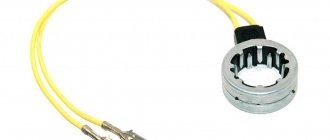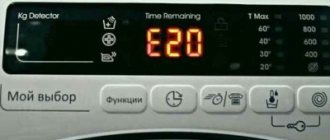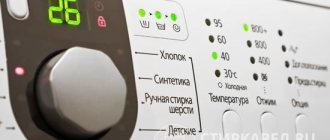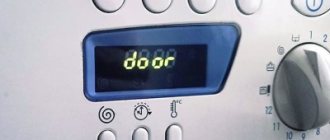The automatic washing machine is controlled by an electronic unit that responds to signals from control devices, the main one of which is a pressure switch. This is a multifunctional sensor responsible for filling the washing tank with water to a certain level, turning on the heating in a timely manner, and pumping out the liquid. Understanding the operating principle of the device and the ability to carry out diagnostics yourself will help save the family budget from unnecessary expenses.
- Purpose of the pressure switch
- Principle of operation and varieties
- Signs of level switch failure
- Self-diagnosis of the pressure indicator
- Is it possible to configure it yourself?
- Do-it-yourself replacement
- Catalog of washing machines with reviews
Purpose of the pressure switch
The pressure switch is a structure consisting of a round-shaped plastic block with electrical wires and a rubber tube attached to it.
A thin hose connects the sensor to the air chamber of the tank, and the wiring goes to the washing machine control unit. Do you store laundry in the washing machine?
Oh yes! No.
The purpose of the pressure switch is to collect and transmit to the command post information about the state of the water level in the tank. Depending on the nature of the received signal, the control board sends a command to perform the next operation according to a given program. It can be:
- turning on the pump to pump water into the drum and drain liquid from the tank;
- starting the engine when washing and spinning clothes;
- initiation of heating of a tubular electric heater - heating element.
The signal is sent due to the deflection of the built-in membrane under the influence of air coming from the tube. This explains the appearance of another name for the device - pressure sensor.
Water level sensor
Principle of operation
The operating principle of the pressure switch is based on reading oscillations that are converted into electronic signals. When water is pumped inside the washing tub of a machine, it creates powerful air vibrations that can be measured. These same vibrations reach the pressure switch core through the hose, pushing away the diaphragm and causing it to hit the central magnet of the device. As a result of the impacts, a pulse is generated that pushes the core into the adjusting screw and thereby sends data to the connected controller through the contacts. The electronic pressure switch thus receives up-to-date information about the extent to which the tank is filled with water.
The controller can determine the volume of filling the central container with water by the type of vibrations emitted. The higher they are, the fewer obstacles inside the washing machine for the propagation of sound waves and the lower the water level. Otherwise, when there is a lot of liquid, it begins to absorb any vibrations, which makes it clear to the computer circuit that there is not enough water and it is not recommended to start washing. When the oscillation frequency drops to the minimum specified by the setting, a corresponding signal is sent to the board through the adjusting screw and the machine stops drawing water through the hose.
At the same time, the factory settings for sensors vary from brand to brand, since they are set by manufacturers at the assembly stage and after that do not attract attention until a breakdown or technical diagnosis occurs. However, over time, due to numerous vibrations along the membrane and core, its height is lost, and the transmission of data on the degree of filling with water becomes less accurate, until the operation stops completely. To return it to operation, you need to disassemble the washing machine, which you can do yourself or entrust to a specialist.
Principle of operation and varieties
Deflection of the membrane causes the closure or disconnection of the contacts through which the impulse passes to the control module. The type of pressure switch depends on the method of signal transmission and the design of the block. There are 2 types of pressure sensors:
- Analogue or mechanical. A pneumatic membrane drive is found in most SMA devices.
- Electronic. The impact on the membrane is an electromagnetic oscillatory circuit. The relays operate at low voltage, 3 wires come from the block.
Expert opinion
I work in the household appliance repair industry. Extensive experience in restoring washing machines and dishwashers.
Ask a Question
In what follows, only mechanical models of sensors will be considered. Pressostats come in single- and double-chamber types. The latter are designed for small and large load machines, when 2 water levels are maintained depending on the amount of laundry being washed.
The membrane is made of rubber or polymer and is located inside the block - the sensor body. Scheme of operation of the device: change in water level - increase/decrease of air pressure in the tube - deflection of the membrane - activation of contacts - electric pulse through the wires to the SMA control unit.
How does the sensor work?
A pressure switch is provided in any automatic machine. It is necessary to control the water level. The sensor sends a signal to the “brain” of the washing machine, notifying the controller about the degree of fullness of the tank. This information is used by the module to control the wash.
The sensor membrane is very sensitive. Under pressure, the rod rises and presses on the plate with the spring. When the water in the tank reaches the desired level, the circuit closes. The pressure switch notifies the module that there is enough water, and the controller starts the next “step” of the wash. At the draining stage, the pressure in the pressure switch tube decreases, the rod begins to descend along with the plate. The electrical circuit is broken.
Signs of level switch failure
A possible malfunction of the pressure switch is often detected by malfunctions of the washing machine. Different modes and programs require the use of appropriate volumes of water. If an abnormal level change occurs, a possible sensor breakdown is detected by the following signs:
- unstable filling of the SMA tank: there is an insufficient amount of water or an excess of it, overfilling of the tank must be prevented by disconnecting the washing machine from the network;
- spinning things does not give the desired result: the laundry remains so wet that water drips from it;
- the presence of a certain amount of liquid in the machine tank after completion of the cycle;
- the fabric rinsing program is not carried out, although it is turned on, unauthorized pumping and filling of water occurs;
- turning on the heating element during the washing process when there is no liquid in the washing machine is a dangerous situation; it’s good if the fuse works and there is no burning smell.
The detection of any of these signs is a reason to check the performance of the SMA. Operating faulty equipment can lead to larger damage to the washing unit.
Pressostat
Symptoms of a problem
Sometimes it is quite difficult to determine the malfunction of a product, especially for people who do not understand technology. It is recommended that you familiarize yourself with the common signs that indicate a faulty pressure switch.
Stops drawing water into the tank
People who have their own washing machine often experience that liquid stops filling into the tank. There are several reasons for this problem:
- Problems with the valve responsible for supplying water. Liquid enters the system under tap pressure. The supply is opened using a special built-in valve, which begins to operate after a signal from the control module. If it is faulty, the liquid will not begin to flow.
- Control module failure. Due to a malfunction of this part, the valve does not receive a signal, and it does not begin to draw water.
- Blocker failure. He is responsible for blocking the hatch door. If the lock is faulty, the machine will not start working.
However, the most common cause is considered to be a faulty pressure switch. If this product does not work, the machine will not be able to evaluate and will not begin to fill the tank.
Repeated cycles of water supply and drainage
Modern washing machines are equipped with an automatic liquid collection system. Not only valves, but also level switches are responsible for the flow of water. All these parts function using special commands coming from the control unit.
A failure in one of the listed parts results in the system not being filled with the required amount of fluid.
The control unit perceives this as a failure to comply with the command, and therefore it re-sends the signal to supply water. This results in the supply and drain cycles being repeated many times. Due to repetition of cycles, the washing time can increase significantly.
Reduced rinse and wash quality
Sometimes, after using a washing machine for a long time, the quality of rinsing and washing clothes gradually deteriorates. Many people attribute this to the use of inappropriate powders. However, there are other reasons why things begin to wash worse.
A common reason for poor washing quality is a faulty level switch. Due to the breakdown of this part, the washer cannot determine how much water is in the tank, and because of this, it often does not fill completely. This leads to the fact that the collected liquid is not enough to properly wash and rinse the washed items.
Water remains after finishing washing
There are times when, after completing work, some water remains inside the drum. This can happen because the pressure switch has failed and stopped functioning normally. If it does not work correctly, the control unit of the device will not receive a signal about the need to clean the tank. This will lead to the pumps not starting to work to pump out excess water.
However, there are other reasons for this problem:
- Pump filter clogged. Obstruction of liquid from the tank sometimes occurs due to a clogged filter. It will have to be cleaned for the drain to start working.
- There is a blockage inside the pipe. During the draining process, the waste liquid passes through the pipe. Experts advise cleaning it once a month to prevent it from becoming clogged.
Self-diagnosis of the pressure indicator
Having the ability to handle a screwdriver, you can try to clarify the cause of the machine malfunction yourself: the listed problems are not always caused by a breakdown of the pressure switch. A mandatory condition for carrying out work is safety.
Before starting the diagnosis, the SMA cord and plug are removed from the power outlet. To get to the control device, you need to perform the following operations:
- on the back wall of the machine, find the screws that secure the top panel, unscrew them, slide the cover towards you - a level sensor is located under it;
- inspect the pressure switch in order to detect external signs of a malfunction: the integrity of the electrical wires, whether the hose has become disconnected from the fitting of the device due to vibrations;
- dismantle the sensor by unscrewing the fastening screws, remove the clamp holding the rubber tube and disconnect the wires;
- clean the hose and fitting from blockages, remove oxide deposits from the contacts and terminals.
After making sure that there is no external damage, proceed to checking the device itself. When disconnecting the wires from the block, they are marked to remember the order of reconnection.
How to check and clean the device
The sensor is checked for functionality only when it is removed from the washing unit. As a rule, it is installed behind the front panel, at the top, located closer to the tank.
The removal and cleaning process is carried out according to the following algorithm:
- It is necessary to de-energize the equipment, that is, remove the plug from the socket.
- Release the back wall by moving the machine away from the wall, or better yet, turn it around.
- The top cover is secured to two bolts located at the back. It's easy to unscrew them using a Phillips screwdriver.
- Lift the edge of the lid a little and pull it back a little.
- Now you can see the pressure switch.
- Find the pressure switch and disconnect the tube from it, and then remove the clamp with pliers.
- Visually inspect the tube for blockages and other defects. If debris is noticed, it should be removed, and if there is damage, it is recommended to replace the tube.
- The wires connected to the programming unit must be disconnected. After the pressure switch terminal, visually inspect and clean.
- Attach a tube of the same diameter to the sensor, providing a supply to the tank, and then blow into the cavity.
If the operation of the pressure switch is normal, clicks are heard from the device, this depends on the water supply mode, usually from 1 to 3.
When checking the sensor to ensure its serviceability, it is recommended to prepare a tall and transparent container with water. The optimal solution would be to use a five-liter bottle with the top cut off. The testing process is simple: the tube must be periodically lowered into the water, and then raised, and clicks can be heard.
Online diagnostics of a washing machine
If your machine stops washing or rinsing clothes normally, then some kind of malfunction or breakdown has occurred.
You can try to find the problem yourself. Run diagnostics
Select which operation your washing machine does not perform:
1. Doesn’t drain 2. Doesn’t rotate the drum 3. Doesn’t spin clothes 4. Noises, knocks, buzzes when spinning 5. Doesn’t turn on
Checking the operation of the drain pump Is the drain pump of the washing machine working? Yes No I don’t know << Back
Clogged hoses in the washing machine If the sound corresponds to the normal sound that has always been observed when the device is working, the cause is probably a clog.
Was there a blockage in the drain hose? Yes
<< Back
The drain pump does not work! If the sound matches the normal sound of the drain pump, it is recommended that you check the drain filter first.
After cleaning, does the drain pump work and does the washing machine drain water? Not really
<< Back
Operation of the drain pump The sound of the pump is usually immediately audible and noticeable. If there is no sound, the pump is not working. We are looking for how to separately enable the water drainage program. As a rule, this is a separate option. After the program has been turned on, the pump should start working in 1-3 seconds. If everything is done correctly and the pump is operational, a buzzing sound will appear. If you hear no buzzing or other sounds when you turn on the program, the pump is probably faulty.
Is the washing machine drain pump working? Not really
<< Back
Clogged car hoses If you have identified a clog in the hoses, you need to disassemble them, clean them, and then reassemble everything.
Does the washing machine drain well? Not really
<< Back
Hurray, you did a great job, you fixed it.
<< Return to the beginning of diagnostics
The drain pump is faulty, call a professional.
<< Return to the beginning of the diagnosis.
The washing machine does not rotate the drum. During the operation of the washing machine, such a problem may occur. Each model has a different drum operation. It rotates according to a given algorithm, which is set by the program. This principle applies to spinning and washing. If you are not sure whether the drum is not spinning or whether it is working, put the laundry in the washing machine. Start the spin program. If the machine is running, it will first drain the water and then start spinning. In this case, a rotational process will be observed. If rotation is not visible, then check the belt. First, turn off the program, then unplug the wire from the outlet so that power does not flow into the device. Now you need to remove the back cover. You will need to carefully inspect the drum belt. It is quite easy to determine whether it is in the wrong position or damaged.
Is the washing machine belt torn or stretched? Not really
<< Back
Broken drum drive belt If the belt breaks, it will be immediately visible. There are also often cases when the belt simply stretches, which is why the drum, accordingly, does not rotate. Do not allow the machine to operate if the belt breaks. It is important to check whether it has wound around the engine pulley or broken the wiring to the engine. The heating element and temperature sensor may also be damaged if the belt does catch the wires. It is imperative to ensure that the belt model is original. If you choose an unsuitable or low-quality product, this will affect the performance of other devices. How do you know what kind of belt you have? There will be a marking written on the old one, compare it with the one indicated on the belt offered to you. You can also find out belt information by car model.
<< Return to the beginning of the diagnosis.
Washing machine motor malfunction If a malfunction is not found, the block with wires must be disconnected from the electric motor. Carefully remove it. We visually evaluate the engine. It may have melting, cracks, or other effects that clearly indicate damage. We call the windings of the tachogenerator and the engine. It is important to understand that you can fully study how correctly the engine operates and whether there is a malfunction only at the stand. If rotation does not occur, there may be a problem with more than just the motor. Sometimes the cause is a malfunctioning electronic module. If a short circuit occurs in the engine, the module could be damaged, while the engine remains operational. Also, the wires could be damaged.
<< Return to the beginning of the diagnosis.
Repairing a washing machine that does not spin clothes After completing the washing process, the washing machine may not spin properly or may not start spinning. Firstly, look, perhaps another mode is set, which does not involve turning on the spin cycle at all. This happens, for example, with programs related to washing woolen items and delicate fabrics. To check, run the spin cycle separately. If the washing machine does not drain water, we proceed to check the pump.
Does the washing machine now spin clothes? Not really
<< Back
Congratulations, you have solved your problem!
<< Return to the beginning of the diagnosis.
Repair of washing machines, imbalance Modern washing machines place the laundry on the drum before spinning. This is necessary for quality work. Check if this feature works. Sometimes a situation occurs when things get wrapped up in a ball that cannot be unwound automatically within a certain time. At this point the work stops. You need to unwind this laundry yourself, lay it out and continue operating the washing machine. In this case, it is important to turn off the machine, and then, when the laundry is laid out, turn on a separate spin program.
Does the washing machine now spin clothes? Not really
<< Back
Washing machine repair, drum drive repair Now you need to check the drum drive belt. We remove the cover and visually assess the condition of the belt. There should be no damage. If the tension is weak, the spin may not turn on. If you need to replace the belt, you should only replace it with the original one. After replacing, we try the program again.
Fault found, does the washing machine spin? Not really
<< Back
The engine or electronic module is faulty, call a repairman to your home.
<< Return to the beginning of the diagnosis.
The washing machine hums, makes noise during the spin cycle, rumbles, and makes a jet plane noise. If the washing machine makes noise during operation, making unusual sounds, it’s time to pay special attention to it. In this case, a visible breakdown or lack of functionality may not be observed, but the appearance of strange sounds indicates that it is time to look for a malfunction. It is important to understand that a new car that has just been delivered should be inspected for shipping bolts. If you forget to remove them, noise and vibration are inevitable. So, let's begin! We turn the washing machine drum and listen to extraneous sounds.
When rotating, do you hear extraneous noise, hum, balls rolling, does the drum move unevenly with slight jamming? Not really
<< Back
If the drum rotates and uncharacteristic sounds appear, including vibration, it’s time to check the bearings. If they malfunction, they will have to be replaced.
<< Return to the beginning of the diagnosis.
The counterweight of the washing machine has come loose. The fastening of the counterweights must also be of high quality. If they are “loose”, it’s time to eliminate this defect. In some cases, you can notice that the bolts that secure the stones are completely missing. In this case, the connectors for mounting will be visible. The bolts need to be found and put in place - they probably simply came loose. A rumble heard while the washing machine is operating may indicate that the bolts have partially loosened. To check the bolts, you can simply push the drum. If it is secure, the bolts are fine. If it moves, there is a defect.
Do you hear any noise, clanging or rattling noises when moving the washing machine tub? Not really
<< Back
The counterweight has come off
<< Return to the beginning of diagnostics
Checking the shock absorbers of the washing machine Checking the shock absorbers. If you hear vibration or excessive noise during the spin cycle, there may be a problem with the shock absorbers. Sometimes the washer moves. Now let's check the functionality. Remove the top cover. Click on the tank, move it five to seven centimeters down. A normal reaction will be observed if the tank rises sharply, jumping a little and stopping in its normal place. If this does not happen, the shock absorbers need to be replaced.
Are the shock absorbers of the washing machine working? Not really
<< Back
If a visible defect has not been identified, check whether a foreign object may have entered the machine. Replacing shock absorbers. The problem with shock absorbers wearing out occurs quite often over time.
<< Return to the beginning of the diagnosis.
Replacing washing machine shock absorbers. Malfunction and wear of shock absorbers is a fairly common phenomenon.
<< Return to the beginning of the diagnosis.
The washing machine does not turn on. It is worth trying to find the cause of the problem yourself and fix it. We start by connecting the device to the network. Next, click on the “network” button. In different car models, different indications are triggered: here either the display will start working, or, on the contrary, some other button.
Does the washing machine have an indicator? Not really
<< Back
Hatch lock lock (UBL) You can check it by turning on any of the programs. We choose what we will use. Click on the corresponding button. Don't forget to pay attention to the inclusion. As a rule, the process of activating a function is characterized by the presence of a certain sound, for example a click, with which the device makes it clear that pressing again is not necessary and the machine is already working. If there is no sound, the button may be broken. In this case, the main thing that must be done is to block the hatch and start working. If this happens, everything is fine.
The washing machine is blocking the hatch and the UBL is triggered? Not really
<< Back
Water fill valve malfunction
<< Return to the beginning of the diagnosis.
The washing machine hatch does not lock
<< Return to the beginning of the diagnosis.
No indication Checking the electrical circuit. If you notice that the washing machine does not respond to being turned on, it is first recommended to check the power supply. The outlet may be faulty. Try connecting another device. If the outlet works, you need to check whether the circuit that conducts energy through the washing machine from one element to another is intact. To do this, you will need a multimeter, which will help you fully analyze the ability to respond to an electrical signal at several stages of operation. If there is no network connection anywhere, this is probably the problem. We carry out this manipulation until we reach the electronic module. If we are talking about an old washing machine, here it will look like the device’s program. When you turn on the button, there should be no breaks in the circuit. If the circuit works, everything is fine electrically.
Is the washing machine's power supply OK? Not really
<< Back
Repair of electronic module (unit)
<< Return to the beginning of diagnostics
Contact circuit fault
<< Return to the beginning of diagnostics
The functionality of the contacts is checked by gently blowing air into the pressure switch chamber through the tube connected to it: 1–3 clicks will be heard from the triggered relay. If you connect the wires of a multimeter to the terminals of the sensor, the latter will show jumps in resistance, which will confirm the serviceability of the electrical part of the pressure switch.
The absence of clicks means that the level sensor is the cause of the machine breakdown. More precisely, the destruction of the membrane inside the chamber. It is better to replace not the diaphragm, but the entire pressure switch, because the cost of the device is low: 1.5–3.5 thousand rubles.
Pressostat in SMA
Consequences of ignoring the problem
Failure of the pressure switch leads to serious consequences, which should be familiarized with in advance. If you do not replace the broken part in time, the following problems will appear:
- Water does not fill up. If the level switch is broken, the liquid stops collecting. In this case, the heating element may turn on, which will lead to further damage to the heating element. Therefore, before starting washing, be sure to check that the tank is not empty.
- Deterioration in wringing out washed items. Sometimes, due to a component failure, the fluid stops draining normally. Because of this, things turn out much worse.
- Tank overflow. Sometimes, due to a broken part, too much water is pumped into the tank, causing it to overflow.
Is it possible to configure it yourself?
The functioning of all systems of the washing machine depends on the correct adjustment of the sensor. To answer the question: is it possible to set up the pressure switch yourself, it is necessary to take into account the circumstances related to the service life of the SMA and the skills of the adjuster. Pay attention to the following recommendations:
- Washing machine warranty period. If it is not finished, the level sensor must be sent to a service center.
- The setup is performed by the manufacturer on a special stand. The adjusting screws are fixed in strict accordance with the SMA software and covered with control varnish or paint to detect unauthorized tampering with factory settings.
- A service specialist who professionally repairs washing machines will not undertake setting up the device at home: he will recommend replacing the pressure switch with a new one.
The reasons given in the list allow us to conclude that repairing a level sensor falls into the category of complex work that is inaccessible to a home craftsman. An alternative option is to purchase an identical new device and install it in place of the faulty one.
Do you wash your shoes in the machine?
Oh yes! No
How to diagnose an electronic temperature sensor (NTC)
The electronic sensor (NTC) changes its resistance as the temperature rises or rises. This is the basis for how to check the temperature sensor of a washing machine of this type. It is this particular feature of the operating principle that gives a 100% analysis result and makes the procedure simple.
You will need a multimeter; it is switched to resistance measurement mode; you can also use an ohmmeter. Next, the detector values are analyzed when exposed to different temperatures.
It is advisable to clarify the test results: compare the resistance of the temperature sensor, the temperature sensor of the washing machine with the table from the specification for a specific sensor model (data can be found on the manufacturers’ websites).
For example, we learn the relationship between the resistance of a thermal sensor and the temperature on an LG washing machine from the specification table for a specific detector with a certain marking:
Algorithm:
- We disconnect the chip and remove the sensor from the socket.
- We switch the multimeter to resistor testing mode, that is, to measure resistance - select 200 kOhm.
- We attach probes to the sensor contacts and look at the result. The normal value at room temperature (+25° C) is about 6 kOhm. The indicated figure is the standard for most products. It is possible that there may be other parameters, so we recommend checking the technical documentation for the washing machine and the specifications of the detector.
- They lower the thermistor into warm water, take repeated measurements, add boiling water and watch how the indicators change. At approximately +50°C the tester should show about 1.5 kOhm. If the value does not change (and it should do this as the liquid cools), then the sensor is broken.
You don’t have to remove the sensor and pour water into the same tank of the washing machine. The principle of such a check is similar to the same procedure for refrigerator sensors, as well as for most household appliances.
Do-it-yourself replacement
In order not to make a mistake in choosing a sensor suitable for the brand of your existing washing machine, it is recommended to take the old pressure switch with you, as well as the SMA technical passport. This will allow the store manager to provide comprehensive information about the purchased model of level sensor, and to verify for himself that the markings on the housings of the old and new pressure switches exactly match.
The sensor is replaced in the reverse order of its removal:
- the tube, disconnected from the previous device, is docked to the fitting of a working pressure switch and tightened with a clamp;
- electrical wires are connected to the sensor in accordance with the pre-applied markings;
- the new pressure switch is attached to its original place, the top cover of the SMA is installed and secured with screws;
- The washing machine cord plug is plugged into the socket.
After completion of the repair, a control wash is performed, during which the result of the new pressure switch is observed. The absence of failures in the specified program means that the replacement was successful.
Without a water level sensor, the washing machine is not able to perform its functions. This important device is individual for each manufacturer. Installing a pressure switch on an SMA from another manufacturer can cause serious problems in the operation of the washing machine.
Video
Hardware sensor test
To check the pressure switch of an Ariston, Samsung, LG or Bosch washing machine using a multimeter, you need to:
- prepare a device for testing resistance;
- place the multimeter probes on the contacts corresponding to the electrical circuit of the sensor;
- create pressure in the air tube until a certain relay contact is activated.
If the resistance value does not change when the contact is activated, it means that the sensor must be replaced.
If all stages of the test have shown that the pressure switch of the washing machine is working, you need to additionally check how the tube is attached to it and evaluate its tightness.
Testing and setting up the sensor
Before you start repairing your “home assistant”, find the receipts and see if the washing machine is under warranty. If the deadline has not passed and you are entitled to free diagnostics, it is better to contact the service center specialists. It should be remembered that if you open the machine body yourself, you can’t hope for warranty service in the future.
If the warranty card is no longer valid, you can proceed with diagnostics. First you need to remove the sensor from the housing. The algorithm of actions will be as follows:
- de-energize the SMA by unplugging the power cord from the outlet;
- turn off the tap responsible for the water supply;
- Unscrew the two bolts securing the top panel of the machine;
- remove the “cover” of the unit;
- find the pressure switch - it has the shape of a washer;
- Unscrew the bolt securing the relay in the housing, remove the connector;
- loosen the clamp and remove the sensor from the machine.
Before adjusting the device, you need to check whether it is working properly. For diagnostics, you will need a rubber tube of the same diameter as on the pressure switch. Having taken out the level sensor, put the prepared tube on its inlet fitting. Then blow into it - the working pressure switch will make 1-3 characteristic clicks. If the device is silent, it means that the contacts do not work and the relay is faulty.
Then inspect the level sensor. You need to make sure that it is not deformed and that there are no traces of burning on the surface. Also check the hose for blockages; sometimes the cavity becomes clogged with dust. If the tube is clogged, clear it or rinse it with warm water.
Hardware diagnostics of the pressure switch is more accurate. To test the device, set the device to resistance measurement mode and attach the multimeter probes to the pressure switch terminals. To activate the contacts, it is necessary to create pressure in the tube.
If the values on the multimeter display remain unchanged when the relay contacts are activated, you will have to replace the pressure switch. If the numbers on the screen change, we can talk about the serviceability of the sensor. Then, perhaps, it will be enough to simply adjust the existing device.
The level sensor is configured manually. Adjustment will be advisable in cases where too little or, on the contrary, too much water is poured into the tank during washing. The amount of liquid collected by the washing machine can be reduced or increased - to do this, you need to set the response force of the pressure switch.
First you need to turn off the power to the machine. Next, remove the top panel of the case, find the pressure switch and disconnect the connector. The relay has three adjusting screws, one of which needs to be tightened. The bolt with which adjustment is made is usually located in the central part.
To tighten the screw, you will need a Phillips screwdriver or a special wrench. The process is carried out in stages - it is necessary to evaluate the intermediate results of adjusting the pressure switch. So, you should turn the bolt half a turn, then assemble the machine body and start a test “idle” wash. If the desired effect is not achieved, you still need to turn the screw.
To set up a pressure switch, you need to have minimal basic knowledge of the internal structure of a washing machine. If you do not have even the slightest idea how a level sensor functions, it is better to invite a specialist to do the work. Otherwise, you can harm the “home assistant” even more.
Interesting:
- How does the pressure switch of a washing machine work?
- Miele dishwasher errors
- Washing machine connection - review
- Checking the pressure switch of the Indesit washing machine
- Error codes for AEG washing machines
- How to adjust the pressure switch of a washing machine
Reader comments
Share your opinion - leave a comment











